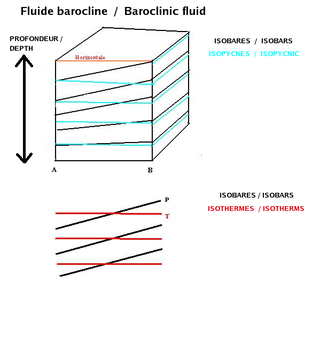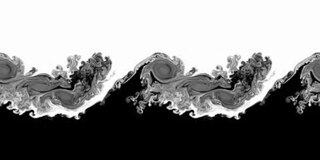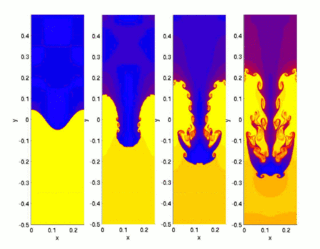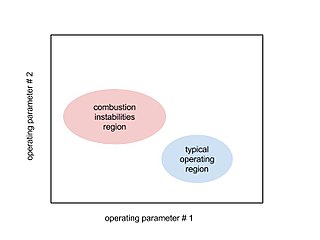
The stability of a plasma is an important consideration in the study of plasma physics. When a system containing a plasma is at equilibrium, it is possible for certain parts of the plasma to be disturbed by small perturbative forces acting on it. The stability of the system determines if the perturbations will grow, oscillate, or be damped out.

In fluid dynamics, the baroclinity of a stratified fluid is a measure of how misaligned the gradient of pressure is from the gradient of density in a fluid. In meteorology a baroclinic flow is one in which the density depends on both temperature and pressure. A simpler case, barotropic flow, allows for density dependence only on pressure, so that the curl of the pressure-gradient force vanishes.

The Kelvin–Helmholtz instability is a fluid instability that occurs when there is velocity shear in a single continuous fluid or a velocity difference across the interface between two fluids. Kelvin-Helmholtz instabilities are visible in the atmospheres of planets and moons, such as in cloud formations on Earth or the Red Spot on Jupiter, and the atmospheres of the Sun and other stars.

The Rayleigh–Taylor instability, or RT instability, is an instability of an interface between two fluids of different densities which occurs when the lighter fluid is pushing the heavier fluid. Examples include the behavior of water suspended above oil in the gravity of Earth, mushroom clouds like those from volcanic eruptions and atmospheric nuclear explosions, supernova explosions in which expanding core gas is accelerated into denser shell gas, instabilities in plasma fusion reactors and inertial confinement fusion.
The potential temperature of a parcel of fluid at pressure is the temperature that the parcel would attain if adiabatically brought to a standard reference pressure , usually 1,000 hPa (1,000 mb). The potential temperature is denoted and, for a gas well-approximated as ideal, is given by
In fluid dynamics, the Taylor number (Ta) is a dimensionless quantity that characterizes the importance of centrifugal "forces" or so-called inertial forces due to rotation of a fluid about an axis, relative to viscous forces.
Ferrofluids can be used to transfer heat, since heat and mass transport in such magnetic fluids can be controlled using an external magnetic field.

Standing, also referred to as orthostasis, is a position in which the body is held in an erect ("orthostatic") position and supported only by the feet. Although seemingly static, the body rocks slightly back and forth from the ankle in the sagittal plane. The sagittal plane bisects the body into right and left sides. The sway of quiet standing is often likened to the motion of an inverted pendulum.

Balance in biomechanics, is an ability to maintain the line of gravity of a body within the base of support with minimal postural sway. Sway is the horizontal movement of the centre of gravity even when a person is standing still. A certain amount of sway is essential and inevitable due to small perturbations within the body or from external triggers. An increase in sway is not necessarily an indicator of dysfunctional balance so much as it is an indicator of decreased sensorimotor control.

Atmospheric instability is a condition where the Earth's atmosphere is considered to be unstable and as a result local weather is highly variable through distance and time. Atmospheric stability is a measure of the atmosphere's tendency to discourage vertical motion, and vertical motion is directly correlated to different types of weather systems and their severity. In unstable conditions, a lifted thing, such as a parcel of air will be warmer than the surrounding air. Because it is warmer, it is less dense and is prone to further ascent.

In fluid dynamics, hydrodynamic stability is the field which analyses the stability and the onset of instability of fluid flows. The study of hydrodynamic stability aims to find out if a given flow is stable or unstable, and if so, how these instabilities will cause the development of turbulence. The foundations of hydrodynamic stability, both theoretical and experimental, were laid most notably by Helmholtz, Kelvin, Rayleigh and Reynolds during the nineteenth century. These foundations have given many useful tools to study hydrodynamic stability. These include Reynolds number, the Euler equations, and the Navier–Stokes equations. When studying flow stability it is useful to understand more simplistic systems, e.g. incompressible and inviscid fluids which can then be developed further onto more complex flows. Since the 1980s, more computational methods are being used to model and analyse the more complex flows.
Energy dissipation and entropy production extremal principles are ideas developed within non-equilibrium thermodynamics that attempt to predict the likely steady states and dynamical structures that a physical system might show. The search for extremum principles for non-equilibrium thermodynamics follows their successful use in other branches of physics. According to Kondepudi (2008), and to Grandy (2008), there is no general rule that provides an extremum principle that governs the evolution of a far-from-equilibrium system to a steady state. According to Glansdorff and Prigogine, irreversible processes usually are not governed by global extremal principles because description of their evolution requires differential equations which are not self-adjoint, but local extremal principles can be used for local solutions. Lebon Jou and Casas-Vásquez (2008) state that "In non-equilibrium ... it is generally not possible to construct thermodynamic potentials depending on the whole set of variables". Šilhavý (1997) offers the opinion that "... the extremum principles of thermodynamics ... do not have any counterpart for [non-equilibrium] steady states ." It follows that any general extremal principle for a non-equilibrium problem will need to refer in some detail to the constraints that are specific for the structure of the system considered in the problem.

In fluid thermodynamics, Rayleigh–Bénard convection is a type of natural convection, occurring in a planar horizontal layer of fluid heated from below, in which the fluid develops a regular pattern of convection cells known as Bénard cells. Bénard–Rayleigh convection is one of the most commonly studied convection phenomena because of its analytical and experimental accessibility. The convection patterns are the most carefully examined example of self-organizing nonlinear systems.

In fluid dynamics, Rayleigh's equation or Rayleigh stability equation is a linear ordinary differential equation to study the hydrodynamic stability of a parallel, incompressible and inviscid shear flow. The equation is:
The interchange instability, also known as the Kruskal–Schwarzchild instability or flute instability, is a type of plasma instability seen in magnetic fusion energy that is driven by the gradients in the magnetic pressure in areas where the confining magnetic field is curved.

Combustion instabilities are physical phenomena occurring in a reacting flow in which some perturbations, even very small ones, grow and then become large enough to alter the features of the flow in some particular way.

Conditional symmetric instability, or CSI, is a form of convective instability in a fluid subject to temperature differences in a uniform rotation frame of reference while it is thermally stable in the vertical and dynamically in the horizontal. The instability in this case develop only in an inclined plane with respect to the two axes mentioned and that is why it can give rise to a so-called "slantwise convection" if the air parcel is almost saturated and moved laterally and vertically in a CSI area. This concept is mainly used in meteorology to explain the mesoscale formation of intense precipitation bands in an otherwise stable region, such as in front of a warm front. The same phenomenon is also applicable to oceanography.

The Rayleigh–Kuo criterion is a stability condition for a fluid. This criterion determines whether or not a barotropic instability can occur, leading to the presence of vortices. The Kuo criterion states that for barotropic instability to occur, the gradient of the absolute vorticity must change its sign at some point within the boundaries of the current. Note that this criterion is a necessary condition, so if it does not hold it is not possible for a barotropic instability to form. But it is not a sufficient condition, meaning that if the criterion is met, this does not automatically mean that the fluid is unstable. If the criterion is not met, it is certain that the flow is stable.
In plasma physics, magnetic buoyancy is an upward force exerted on magnetic flux tubes immersed in electrically conducting fluids under the influence of a gravitational force. It acts on magnetic flux tubes in stellar convection zones where it plays an important role in the formation of sunspots and starspots. It was first proposed by Eugene Parker in 1955.















